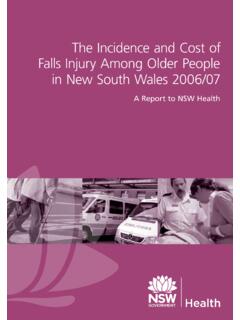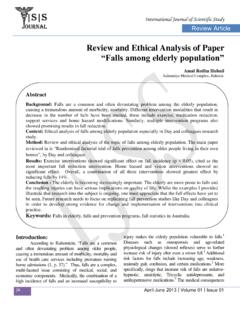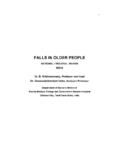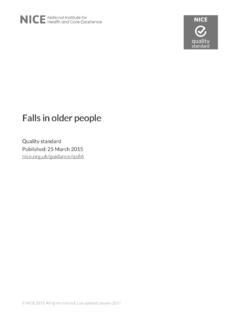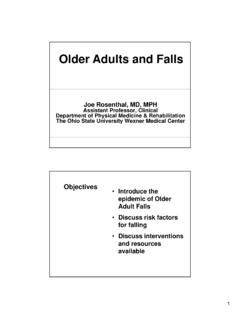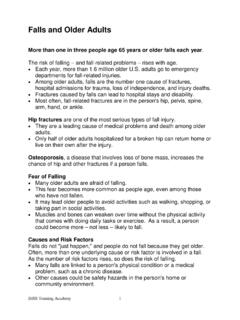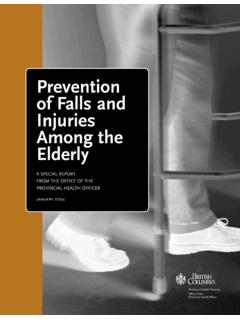Transcription of What are the main risk factors for falls amongst older ...
1 What are the main risk factors for falls amongst older people and what are the most effective interventions to prevent these falls ? March 2004 ABSTRACT This report is HEN s response to a question from a decision-maker. It provides a synthesis of the best available evidence, including a summary of the main findings and policy options related to the issue. fall prevention programmes can be effective in reducing the number of people who fall andthe rate of falls . Targeted strategies aimed at behavioural change and risk modification for those living in the community appear to be mostpromising. Multifactorial intervention programmes that include risk factor assessment and screening have beenshown to be effective. However, no screening tools have been rigorously validated across countries and furtherwork is needed in this area. HEN, initiated and coordinated by the WHO Regional Office for Europe,is an information service for public health and health care decision-makers in the WHO European Region.
2 Other interested parties might alsobenefit from HEN. This HEN evidence report is a commissioned work and the contents are the responsibility of the authors. Theydo not necessarily reflect the official policies of WHO/Europe. The reports were subjected to international review, managed by the HEN team. When referencing this report, please use the following attribution: Todd C, Skelton D. (2004) What are the main risk factors for falls among older people and what are the most effective interventions to prevent these falls ?Copenhagen, WHO Regional Office for Europe (Health EvidenceNetwork report; , access ed 5 April 2004). Keywords ACCIDENTAL falls ACCIDENT PREVENTION AGED RISK factors EVIDENCE-BASED MEDICINE DECISION SUPPORT TECHNIQUES E UROPE Address requests about publications of the WHO Regional Office to: by e-mail (for copies of publications) (for permission to reproduce them) (for permission to translate them) by post Publications WHO Regional Office for Europe Scherfigsvej 8 DK-2100 Copenhagen , Denmark World Health Organization 2004 All rights reserved.
3 The Regional Office for Europe of the World Health Organization welcomes requests for permission to reproduce or translate its publications, in part or in full. The designations employed and the presentation of the material in this publication do not imply the expression of any opinion whatsoever on the part of the World Health Organization concerning the legal status of any country, territory, city or area or of its authorities, or concerning the delimitation of its frontiers or boundaries. Where the designation country or area appears in the headings of tables, it covers countries, territories, cities, or areas. Dotted lines on maps represent approximate border lines for which there may not yet be full agreement. The mention of specific companies or of certain manufacturers products does not imply that they are endorsed or recommended by the World Health Organization in preference to others of a similar nature that are not mentioned.
4 Errors and omissions excepted, the names of proprietary products are distinguished by initial capital letters. The World Health Organization does not warrant that the information contained in this publication is complete and correct and shall not be liable for any damages incurred as a result of its use. The views expressed by authors or editors do not necessarily represent the decisions or the stated policy of the World Health Organization. 2 What are the main risk factors for falls amongst older people and what are the most effective interventions to prevent these falls ? How should interventions to prevent falls be implemented? March 2004 The Policy Sources for this Incidence of falls and associated Risk Assessment of Prevention of falls and Costs and prevention of Gaps in evidence and conflicting Current debate on populations and strategic Successful multifactorial Recent guidelines and health service Conditions to support successful 3 What are the main risk factors for falls amongst older people and what are the most effective interventions to prevent these falls ?
5 How should interventions to prevent falls be implemented? March 2004 Summary The issue older people make up a large and increasing percentage of the population. As people grow older they are increasingly at risk of falling and consequent injuries. A fall may be the first indication of an undetected illness. The prevention of falls is of major importance because they engender considerable mortality, morbidity and suffering for older people and their families, and incur social costs due to hospital and nursing home admissions. Findings Approximately 30% of people over 65 fall each year, and for those over 75 the rates are higher. Between 20% and 30% of those who fall suffer injuries that reduce mobility and independence and increase the risk of premature death. fall rates among institution residents are much higher than among community-dwellers. fall prevention programmes can be effective in reducing the number of people who fall and the rate of falls .
6 Targeted strategies aimed at behavioural change and risk modification for those living in the community appear to be most promising. Multifactorial intervention programmes that include risk factor assessment and screening have been shown to be effective. However, no screening tools have been rigorously validated across countries and further work is needed in this area. The use of physical and pharmacological restraints leads to more severe injuries from falls . Patients with cognitive impairment in hospital after a fall have not benefited from multifactorial interventions, but cognitively impaired residents of care facilities have responded to tailored fall prevention. It seems likely that fall prevention programmes can be cost effective, although more research is required. Policy considerations Unless concerted action is taken, the number of falls is likely to increase over the next 25 to 30 years. A number of interventions targeted to individuals have been shown to work, but population-based strategies have not been properly evaluated.
7 This points to the need for monitoring and further evaluation. Health and social care agencies need to work together to prioritize fall prevention as part of their overall strategy for promoting healthy ageing. Coherent multidisciplinary programmes can be developed at the national level. These should be implemented with national data collection mechanisms to evaluate interventions by outcome ( fall /fracture rates) rather than process ( people seen) or structure (clinics set up). Effective interventions used in a multifactorial programme include: home-based professionally prescribed exercise, to promote dynamic balance, muscle strengthening and walking group programmes based on Tai Chi-type exercises or dynamic balance and strength training as well as floor coping strategies home visits and home modifications for older people with a history of falling medication review, particularly for those on four or more medicines and withdrawal of psychotropic medications where feasible.
8 4 What are the main risk factors for falls amongst older people and what are the most effective interventions to prevent these falls ? How should interventions to prevent falls be implemented? March 2004 Authors1 of this HEN synthesis report are: Dr Dawn Skelton Project Co-ordinator - Prevention of falls Network Europe School of Nursing, Midwifery and Health Visiting Coupland III University of Manchester Oxford Road Manchester, M13 9PL United Kingdom Tel: +44-161 275 8225 E-mail: Professor Chris Todd Professor of Primary Care and Community Health and Dean of Research School of Nursing, Midwifery and Health Visiting Coupland III University of Manchester Oxford Road Manchester, M13 9PL United Kingdom Tel: +44-161-275 5336 E-mail: Introduction A fall is usually defined as an event which results in the person coming to rest inadvertently on the ground or other lower level, and other than as a consequence of the following: sustaining a violent blow, loss of consciousness, sudden onset of paralysis, or an epileptic seizure (1).
9 falls and fall -related injuries among older people are major issues for health and social care providers in Europe and indeed the world, because of the rapid increases in life expectancy observed during the twentieth century (2). falls are the most serious and frequent home accident among older people . They are a major reason for admission to hospital or a residential care setting, even when no serious injury has occurred (2,3). fall -induced injuries are increasing more rapidly than can be accounted for by the increase in the elderly population (4,5). Epidemiological research into falls and fall -related injuries has been effected by a series of conceptual and methodological problems. Although the majority of hip fractures resulting from falls come to the attention of health professionals, less severe injuries may not result in medical attention. Given that the majority of falls do not come to the attention of any medical service (6), incidence figures for falls in the community setting are largely dependent on self-reported recall of events.
10 Despite these issues, there are a number of broad conclusions about fall incidence that can be drawn from the literature. Sources for this review This synthesis has concentrated on identifying evidence that emerges from published systematic reviews of the literature (3,7,8,9,10,11), general reviews (12,13,14,15,16,17,18) and key studies published in English. Due to the short time for completion and breadth of the question, this cannot be 1 Dr Skelton and Professor Todd are co-ordinators of the Prevention of falls Network Europe (ProFaNE), European Commission contract QLRT-2001-02705. The content of the manuscript does not represent the opinion of the European Community and the Community is not responsible for any use that might be made of the information presented in the text. Contact 5 What are the main risk factors for falls amongst older people and what are the most effective interventions to prevent these falls ?












